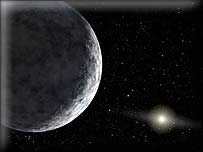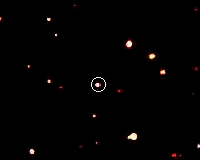Planet 10 Astronomers in the United States have announced the discovery of the 10th planet to orbit our Sun.
07.29.05 - Originally posted on space.com
 Astronomers have discovered an object in our solar system that is larger than Pluto. They are calling it the 10th planet, but already that claim is contested. Astronomers have discovered an object in our solar system that is larger than Pluto. They are calling it the 10th planet, but already that claim is contested.
The new world's size is not at issue. But the very definition of planethood is.
It is the first time an object so big has been found in our solar system since the discovery of Pluto 75 years ago.
The announcement, made today by Mike Brown of Caltech, came just hours after another newfound object, one slightly smaller than Pluto , was revealed in a very confusing day for astronomers and the media.
The new object, temporarily named 2003 UB313, is about three times as far from the Sun as is Pluto.
"It's definitely bigger than Pluto," said Brown, a professor of planetary astronomy. The object is round and could be up to twice as large as Pluto, Brown told reporters in a hastily called NASA-run teleconference Friday evening.
His best estimate is that it is 2,100 miles wide, about 1-1/2 times the diameter of Pluto.
One of many?
The object is inclined by a whopping 45 degrees to the main plane of the solar system, where most of the other planets orbit. That's why it eluded discovery: nobody was looking there until now, Brown said.
Some astronomers view it as a Kuiper Belt object and not a planet. The Kuiper Belt is a region of frozen objects beyond Neptune.
Pluto is called a Kuiper Belt object by many astronomers. Brown himself has argued in the past for Pluto's demotion from planet status, because of its diminutive size and eccentric and inclined orbit .
But today he struck a different note.
 |
| The planet, circled here, is seen moving across a field of stars. The three images were taken about 90 minutes apart. |
"Pluto has been a planet for so long that the world is comfortable with that," Brown said in the teleconference. "It seems to me a logical extension that anything bigger than Pluto and farther out is a planet."
Offering additional justification, Brown said 2003 UB313 appears to be surfaced with methane ice, as is Pluto. That's not the case with other large Kuiper Belt objects, however.
"This object is in a class very much like Pluto," he said.
NASA effectively endorsed the idea in an official statement that referred to 2003 UB313 as the 10th planet.
Yet in recent years, a bevy of objects roughly half to three-fourths the size of Pluto have been found.
No definition for 'planet'
Brian Marsden, who runs the Minor Planet Center where data on objects like this are collected, says that if Pluto is a planet, then other round objects nearly as large as Pluto ought to be called planets. On that logic, 2003 UB313 would perhaps be a planet, but it would have to get in line behind a handful of others that were discovered previously.
"I would not call it the 10th planet," Marsden told SPACE.com .
Alan Boss, a planet-formation theorist at the Carnegie Institution of Washington, called the discovery "a major step." But Boss would not call it a planet at all. Instead, he said Pluto and other small objects beyond Neptune should be called, at best, "Kuiper Belt planets."
"To just call them planets does an injustice to the big guys in the solar system," Boss said in a telephone interview.
The very definition of what constitutes a planet is currently being debated by Boss and others in a working group of the International Astronomical Union. Boss said the group has not reached consensus after six months of discussion.
The debate actually stretches back more than five years and is rooted in the fact that astronomers have never had a definition for the word "planet," because the nine we knew seemed obvious.
"This discovery will likely re-ignite a healthy debate about what is and what is not a planet," Boss said.
Next up: Mars-sized objects?
Alan Stern, of the Southwest Research Institute and leader of NASA's New Horizons mission to Pluto, predicted in the early 1990s that there would be 1,000 Plutos out there. He has also contended, based on computer modeling, that there should be Mars-sized worlds hidden in the far corners of our solar system and even possibly other worlds as large as Earth.
In a telephone interview after Friday's announcement, Stern, who was not involved in the discovery, said he stands by those predictions and expects Mars-sized objects to be found within decades.
"I find this to be very satisfying," Stern said of 2003 UB313. "It's something we've been looking for for a long time."
Stern stopped short of calling it one of the greatest discoveries in astronomy, however, because he sees it as just one more of many findings of objects in this size range. Last year, for example, Brown's team found Sedna , which is about three-fourths as large as Pluto. Others include 2004 DW and Quaoar .
Stern sees the outer solar system as an attic full of undiscovered objects.
"Now we have the technology to see them," he said. "We're just barely scratching the surface."
Way out there
The new world is about 97 astronomical units from the Sun. An astronomical unit is the distance between the Sun and Earth. It becomes the farthest-known object in the solar system, and the third brightest of the Kuiper belt objects.
It is colder than Pluto and "not a very pleasant place to be."
It was found using the Samuel Oschin Telescope at Palomar Observatory.
Backyard astronomers with large telescopes may be able to spot the planet No. 10.
"It will be visible over the next six months and is currently almost directly overhead in the early-morning eastern sky, in the constellation Cetus," says Brown, who made the discovery with colleagues Chad Trujillo, of the Gemini Observatory, and David Rabinowitz, of Yale University, on Jan. 8.
The team had hoped to analyze the data further before announcing the planet but were forced to do so Friday evening because word had leaked out, Brown said.
"Somebody hacked our website," he said, and "they were planning to make [the data] public."
Brown and Trujillo first photographed the new planet with the 48-inch Samuel Oschin Telescope on Oct. 31, 2003. However, the object was so far away that its motion was not detected until they reanalyzed the data in January of this year. In the last seven months, the scientists have been studying the planet to better estimate its size and its motions.
Estimating size
Scientists infer the size of a solar-system object by its brightness and distance. The reflectiveness of the new planet is not known, however, which is why the estimate of its diameter ranges from one to two times the size of Pluto. But those constraints are well supported by the data, Brown said.
"Even if it reflected 100 percent of the light reaching it, it would still be as big as Pluto," says Brown. "I'd say it's probably one and a half times the size of Pluto, but we're not sure yet of the final size. But we are 100 percent confident that this is the first object bigger than Pluto ever found in the outer solar system."
The upper size limit is constrained by results from the Spitzer Space Telescope, which records heat in the form of infrared light. Because the Spitzer can't detect the new planet, the overall diameter must be less twice Pluto's size, Brown said.
Brown has had a running bet for five years with a friend that an object larger than Pluto would be found by Jan. 1 this year. 2003 UB313 was spotted on Jan. 8.
"My first reaction was, 'aw, I lost the bet by seven days,'" he said.
Brown's team has submitted a name proposal to the International Astronomical Union and has chosen not to divulge it until that body makes a decision.
Links:
http://www.space.com/scienceastronomy/050729_new_planet.html
http://www.nasa.gov/vision/universe/solarsystem/newplanet-072905.html
http://news.bbc.co.uk/2/hi/science/nature/4730061.stm
|

